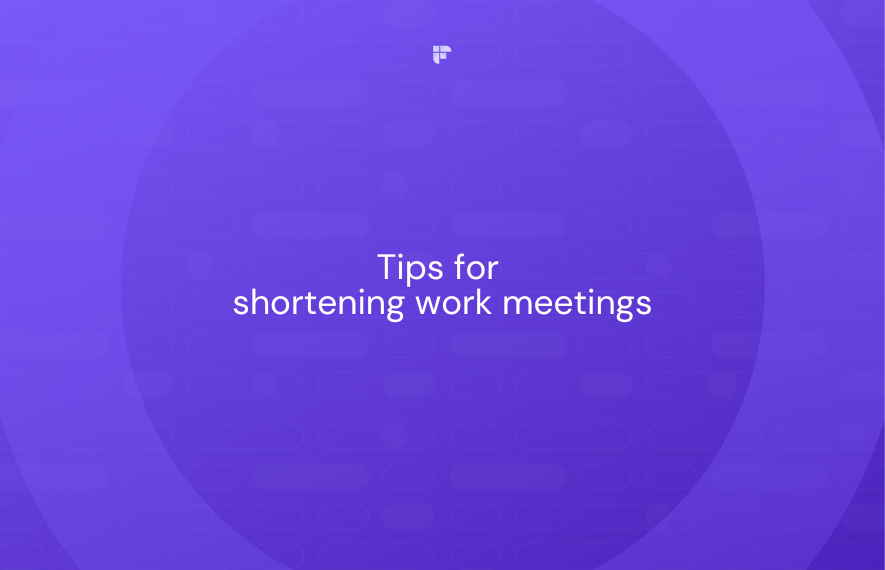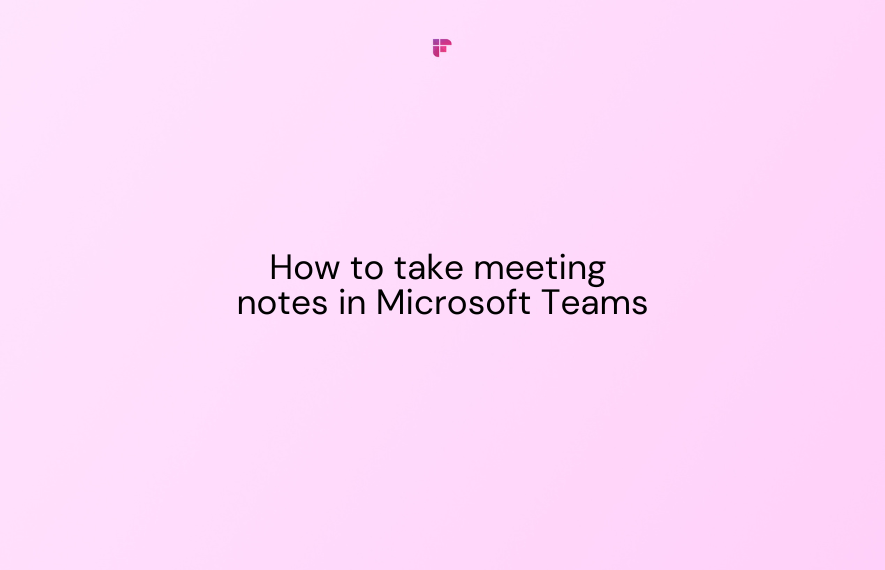For how many hours in a day do you actually feel productive? And how much time out of this is wasted in unnecessary meetings?
A survey revealed that in an average week, 5% of US professionals were in a video conference for more than 20 hours.
Being stuck in back-to-back, inefficiently run meetings consumes a big chunk of your time and energy. However, there are ways to keep meetings short and make them work.
Let's go through different ways to shorten your meetings.
1. Set agenda in advance
Do you find your colleagues consistently arriving at meetings without proper preparation?
Efficiency in group work is a challenge when the objectives are unclear. Groups thrive on purpose and meaning; in their absence, their members spend considerable time searching for direction.

If you're keen on conducting brief and efficient meetings, creating an agenda and distributing it beforehand is an excellent way to guarantee everyone arrives with a clear understanding of what to anticipate. A defined sense of purpose brings energy into the group, maintaining a sharp focus.
Communicating this direction before the meeting is ideal, ensuring minimal time is wasted on tasks that lack relevance.

2. Include material that'll help in the meeting
Sharing preparatory materials before each meeting is an effective strategy to ensure everyone is well-acquainted with the subject matter. If you aim to optimize time spent delving into specific topics during meetings, this approach guarantees that all participants enter the meeting with a uniform foundational knowledge.
When making decisions, it's all about the stories and narratives. Crafting a well-thought-out, short narrative and passing it around before the meeting packs more punch than throwing up a PowerPoint that just puts everyone in a zoning-out mode.

3. Start at an unusual time
The usual drill is to kick off meetings right on the hour or half-hour. It's convenient for stacking meetings one after the other but also tends to breed perpetual tardiness. People use the short break to grab a drink, hit the restroom, or check emails, making everyone wait for the stragglers.
A nifty workaround for this issue is to throw in a curveball and start the meeting at an odd time, like 10:10 or 2:37. The quirky start time has a couple of perks.
Firstly, folks get a breather between meetings.
Secondly, the unusual timing grabs their attention, making them think there's some important reason for the precision, and voila, punctuality improves.
4. Schedule for alternative time blocks
Being a creature of habit, you might often opt for 30- or 60-minute time blocks. However, if you are certain you could achieve your meeting goals in 50 minutes, then schedule a meeting for just 50 minutes.
This will encourage a very focused approach; you can move the meeting along as planned.Choosing longer durations may invite unnecessary discussions, making the meetings last much longer than they should.
5. Have allotted time for topics
It's one thing to have a meeting agenda, but taking it up a notch involves using a template with dedicated time slots for each topic. Planning your agenda with precision ensures you've divvied up the right amount of time for each discussion point.
Work tends to stretch to fit the time you give it. If you need 20 minutes for a topic, just stick to that. It'll keep everyone on track and keep the meeting moving as intended.
Being aware of the time allocated to each topic ensures your meeting doesn't stretch beyond its scheduled duration. For an extra layer of assurance, think about timing each section in real time.
6. Restrict the number of people
Be mindful and only invite necessary key players to meetings. Try to avoid unnecessary invites, as each participant's time is valuable.

If certain individuals can be briefed post-meeting or asynchronously, you can share meeting notes with them.
Remember that whenever you invite someone to a meeting, you're deducting time out of their day and reducing the hours they have for vital tasks.
7. Have a facilitator
Having meeting roles is absolutely crucial for a successful meeting. It transcends mere participation; it ensures comprehensive coverage of all essential aspects. The aim is to maintain a seamlessly orchestrated atmosphere throughout the meeting.
Meetings sometimes hit a snag, and everyone's stuck trying to figure things out. That's the perfect moment for a facilitator to step in.
Their main goal is keeping teams from getting stuck in the first place or helping them get unstuck if they're already there. Facilitators come prepared with a toolbox full of activities and tricks to navigate a group through the tough spots smoothly, keeping the pain and effort to a minimum.

8. Use the parking lot method
During meetings, envision the parking lot as the designated zone for jotting down ideas, comments, and concerns that may not align with the ongoing discussion. This ingenious tool serves as a reservoir for potentially pivotal thoughts, ensuring the meeting stays sharp, focused, and on course.
As a meeting facilitator, the parking lot method stands out as a formidable tool at your disposal. This approach involves strategically "parking" a discussion to be revisited at a more fitting juncture.
Should a particular dialogue veer off course from the meeting agenda, assert your authority as the host to gracefully usher the conversation into the parking lot for later consideration.
If you sense the conversation derailing or a topic better suited for a parking lot emerges, look for any pause to interject and guide the dialogue back on track. As the host, your responsibility is to ensure a smooth meeting, assuring participants that sidelined issues will be revisited at an appropriate time.
9. Save Q&As for later
While Q&A sessions enhance transparency and provide clarity, they often consume valuable time. To combat this issue, consider leveraging asynchronous communication platforms.

You can designate a specific day and time weekly for team members to pose their questions through these channels. This provides flexibility for thoughtful responses within your timeframe and allows you to have shorter meetings.
10. Have time-related meeting rules
Ground rules are basic principles that meeting participants need to follow to have more effective meetings. If everyone has a shared understanding of how to proceed, you could keep meetings short and productive.
Consider incorporating rules such as:
- starting and ending on time,
- addressing only prepared topics,
- adhering to the agenda, and
- ensuring meetings have a clear purpose
With the shift to remote and hybrid working setups, additional ground rules may be necessary to optimize the virtual collaboration experience.
You can have it all with an AI assistant
What if there was a one-stop solution that took care of all the little details to keep your meetings short, sweet, and effective? Having an AI assistant can help you get there.
Fireflies.ai is an intelligent assistant designed to enhance your meeting efficiency by automating note-taking and documentation. It seamlessly integrates into your work meetings, capturing and transcribing discussions and providing key points and action items.

Fireflies.ai can help you save crucial time by offering practical solutions to keep meetings short.
Auto-generate meeting summary: Fireflies generates custom notes and various content types, including emails, from the meeting transcript for efficient post-meeting workflows.
Smart Search: You can navigate meeting transcripts swiftly with Smart Search. Use filters like date, time, questions, metrics, etc., or chat with the AI assistant Fred to quickly find important information and review meetings in minutes.
Track topics: Easily track key phrases or words with Topic Tracker. Fireflies will flag and filter parts of the meeting transcripts where these are mentioned.
Collaborate: Enhance teamwork with features like Soundbites, enabling easy sharing of valuable meeting excerpts for future reference.
Integrate: Integrate Fireflies with popular CRM, productivity, and other business tools, eliminating the hassle of entering meeting notes manually.
💡 Say goodbye to meeting fatigue with Fireflies!
Integrate with Fireflies—minimize meeting fatigue and create more space for deep, meaningful work.






